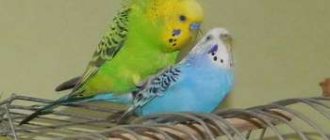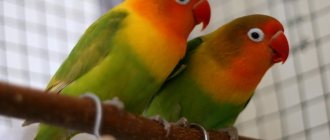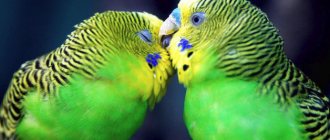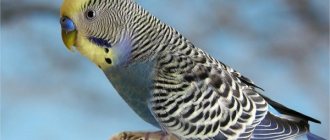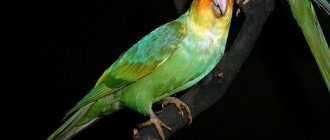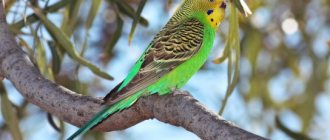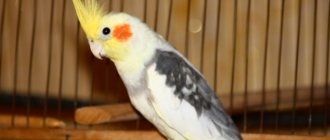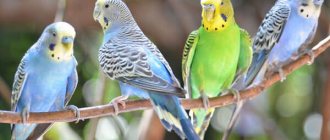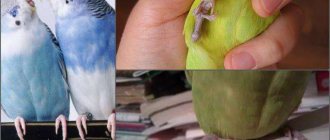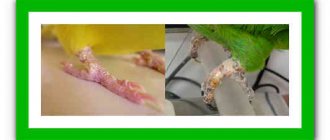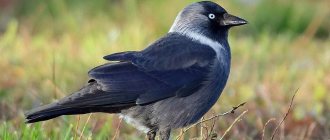- home
- Parrot
- Breeding
05/21/2019 Breeding lovebirds at home requires compliance with a number of conditions. In order for the process to be successful and a pair of parrots to produce healthy offspring, it is necessary not only to choose the right future parents, but also to provide them with an environment favorable for reproduction. This applies to both creating a comfortable microclimate and creating the right balanced menu. When starting the business of breeding parrots, it is important for a breeder to be prepared for difficulties that arise beyond the control of humans. This article will discuss how to properly reproduce lovebirds, as well as how to cope with possible problems.
How to choose healthy parents for the future offspring of lovebirds
Individuals older than 1 year are suitable for reproduction. Birds should have a good appetite and healthy, clean plumage. Examine the eyes and beak: there should be no discharge. Birds must be mentally healthy, not rush around the cage and not twitch from any rustle. An aggressive lovebird can peck a female during courtship.
Any physical abnormalities - a drooping wing, lameness, bald spots - become a reason for rejection. An external examination cannot guarantee the complete health of an individual. Before a couple is placed together, it is necessary to be tested for the main types of parasites and common avian infections.
First, it is better to purchase a male and place him in a cage, then add a female to him. If the feathered owner is the first to inhabit the cage, then she may not allow the gentleman into her territory at all. If the owner sees that the male lovebird has pecked his girlfriend, it means that he is not ready to be a neighbor. It is better to put them in different cages and place them side by side. Over time, the birds will get to know and get used to each other. In a month you can move them together.
If they take a pair, they buy them in different places so that the pets do not end up from the same litter. At home, lovebirds are moved into a new cage. Going through a period of adaptation together in a new place, they will become friends.
Age of feathered parents
This indicator is very important for breeding a pair of lovebirds without the help of an ornithologist at home. If the birds' plumage is faded and there is a clearly defined black spot near the beak, they are no more than 2 months old.
The first molt begins at 4–6 months from the frontal part of the head. The next period will begin in a year, after which it is almost impossible to determine the age of the bird.
At 9 months, the reproductive system of lovebirds is fully formed, but they are not yet ready to reproduce. The barely grown chicks themselves will not yet be able to properly care for their offspring. Young parents and their brood are more likely to become ill, leading to mortality.
When lovebirds are one year old, they are completely ready to breed. Up to 4 years old birds retain the ability to give birth to healthy offspring.
Selection of a pair of parrots
To select a suitable match, you need to take into account a number of factors, including their health and degree of relationship, age and size.
Health status
Only healthy individuals can produce healthy offspring, so the first thing to do is to take the intended parents to a veterinarian for examination. The doctor will most likely prescribe tests after a visual examination. In addition, he will ask the owner about the behavior and habits of the bird, its level of activity and appetite.
Important! Birds should not be allowed to engage in mating during the molting period; the body at this time is weakened and susceptible to disease.
Weights
Each subspecies of lovebirds has an average normal weight for a healthy individual, for example, Rosy-cheeked - 55 g, Liberian - 35 g, and so on.
An overweight pet is not ready for nesting; it is apathetic and clumsy. In addition, excess excess weight can affect the functioning of the entire body. To normalize the condition of the bird, you need to increase its physical activity and adjust its diet.
Training can include flying around the room, and a rice diet is used to lose weight.
Being underweight is just as unacceptable as being obese. A physically weakened individual will not have enough strength to lay eggs, hatch a clutch, or feed. Not to mention that the eggs may be defective.
Did you know? In Australia, special schools for parrots have been created; any owner can bring his feathered pet to an institution where he will be taught to talk.
Optimal age
Despite the fact that individuals become sexually mature by nine months, they begin to mate at one year of age. Birds that are too young are not ready to become parents. The optimal age for obtaining healthy offspring and a responsible attitude of the parent couple is from one to four years.
Older parrots most often do not produce healthy offspring; the reproductive system cannot cope with the load.
Close family connections
Inbreeding, or the connection of close relatives, is not desirable in home breeding. Without the special knowledge and technologies that specialists use when working with inbreeding, you can end up with failure instead of quality offspring.
Anomalies resulting from closely related relationships:
- dummy eggs;
- abnormally small clutch (on average there are from four to eight pieces);
- chick mortality;
- chicks with signs of pathologies.
It will also be useful for you to know: how to properly care for lovebirds, whether it is possible to keep lovebirds alone, all the most important things about lovebird chicks.
Excess weight
Lovebirds have a tendency to become obese. This disease disrupts the functioning of the bird’s internal organs; such individuals are not inclined to nest. Before mating, the birds are put on a rice diet for 7 days. It includes rice porridge with water, greens, and sprouted grains. It is recommended to open the cage more often to allow the birds to fly around the room. This way they train the heart muscle and lose excess weight.
After a week of dietary nutrition, fruits and vegetables are introduced into the diet. You shouldn’t lose weight too much, especially for females. They may not survive the entire nesting period, and problems with egg laying will begin.
Birds from the same brood or family
A pair of birds must be purchased from different nurseries or from different breeders. Parrots that are close in blood cannot become parents of full-fledged offspring. This can lead to various complications:
- empty, unfertilized eggs;
- small masonry;
- poor survival of offspring;
- external defects in chicks.
On a note. Close relationships are used for breeding birds and obtaining new shades of plumage. This method is not suitable for crossing lovebirds at home.
Living conditions and care for lovebirds at home
To keep lovebirds at home, you should choose a bright, well-ventilated room, without drafts. There should be no windows or heating devices near the cage.
You cannot keep the cage on the floor. It is better to install it on a table, shelf or hang it from the ceiling.
Lovebirds love to chew on everything. The same applies to the cell. Therefore, its rods should not contain copper or zinc. These substances can cause poisoning. The minimum cage dimensions are 40/50/80 cm.
It should be equipped with:
1. Wooden perches. There should be 2-3 of them. Plastic options can lead to the formation of corns.
2. Feeders and drinkers.
3. Various toys. These should be swings, ladders and ropes.
Twice a week you should wash all the perches and rods with warm water and a toothbrush. The bottom of the cage should be dry with paper towels and organic sand.
Don't put newspapers down. Birds can chew them, which will lead to poisoning. The paper is changed when it gets dirty.
To live a full life, birds need to fly. It is better to let them out of the cage when you are at home. At the same time, all doors and windows must be closed so that the bird does not accidentally fly out into the street.
It is also worth covering the windows with curtains. This will protect the bird from colliding with the glass. You should not force parrots into a cage. You should wait until they want to come in or lure them in with treats.
Like all birds, the lovebird wakes up at dawn and goes to sleep after sunset. Therefore, late in the evening you need to cover the cage and not turn on loud music or TV. If the bird does not get enough sleep, it will be weak and passive.
Lovebirds love to splash in the water, so during hot weather they should put a bathing suit in their cage twice a week. After water procedures, make sure that the bird does not get sick. To do this, eliminate all drafts and turn on an infrared lamp next to the cage.
In winter, the bathing suit should be installed once a week. In order for the parrot to dry out as quickly as possible, you need to turn on the heater.
Advice! Never blow dry your bird. This will not only do her no good, but it will also frighten her.
Mutual sympathy
When several males and females live in enclosures in nurseries, they choose their own mate. These birds make wonderful parents; they reproduce without problems at home. For lovebirds, mutual sympathy is very important.
If a couple stays together for a long time and no offspring appear, it is possible that these are same-sex birds, or one of the partners is not ripe for mating.
How to create the necessary conditions in winter
If birds decide to lay eggs in the cold season, you need to think about creating all the necessary conditions. A humidifier must be running in the room where parrots are kept. Required air humidity is 60%. Temperature conditions are also important for breeding lovebirds and producing healthy offspring at home. The air is not heated above +20 °C, and the temperature is not allowed to drop below +18 °C.
Additional lamps are placed in the rooms, daylight is extended to 15 hours a day. Heating lamps with a power of no more than 60 W are placed next to the cage.
The necessary conditions
Male and female lovebirds are extremely emotional birds. It is extremely difficult to understand on what criteria the choice of a pair for mating is based.
The right time for mating
Lovebirds, which many people breed at home, tend to form a pair in the summer or early autumn. In summer, the daylight hours are longer and there are more vitamin-rich foods.
Artificial climate
In an artificially created situation, lovebirds begin to reproduce only if the room temperature and air humidity are suitable for them. The optimal temperature is considered to be within +18-20 degrees Celsius with an air humidity of 50-60%. If the room is too hot or dry, you will have to spray water in the corners of the house, otherwise the life of lovebirds will not be very comfortable, which will affect their desire to reproduce.
In the cold season, the cage where lovebirds live is equipped with lamps with a power of 40-60 watts. During the period of mating and incubation, the room where the parrots are located must be light for at least 15 hours. In unsuitable conditions, lovebirds will not mate.
Diet
In summer and autumn, lovebirds eat vegetables, fruits, and greens, so the question of what to feed lovebirds should not arise. In winter, parrots should receive special vitamin complexes. On the eve of nesting, the following is added to the usual menu:
- cottage cheese;
- eggs;
- mealworms;
- insects
It is important for the female to get as much protein as possible. But you shouldn’t limit yourself to just one. At home, birds are regularly fed:
- oatmeal, rice and pea porridge;
- sprouted rice, wheat and oats;
- young branches of fruit trees;
- honey (2 g daily);
- lemon juice (3 drops daily).
To make up for the loss of calcium and phosphorus at home, feed foods rich in them, for example, a few sesame seeds or almonds will not harm the female. In the wild, she finds everything she needs on her own.
Every day, the birds' homemade menu is diluted with a calcium gluconate tablet crushed to flour. For better absorption of calcium, it is sometimes permissible to dilute the usual diet with vitamin D products. Water and food are changed at least once every 2-3 hours. If vitamins have been added to the water, remove the bowl immediately after the birds have drunk.
Two houses
In addition to a spacious cage, which is a home for birds, mating individuals need an additional place to live. A small house in which the female will build a nest is hung on the cage.
In the cage itself, where lovebirds spend most of their time, containers for food and water, mineral stones, and a perch are installed.
Nest construction
Ready for reproduction, the female uses branches of deciduous trees to build a nest (this makes caring for her at home much easier), which a person needs to attach to the entrance to the nest box. Before being placed in a cage, the leaves are treated with hot water.
Females carefully select building material, using one selection method that they understand. At the same time, some birds even use paper to cover the bottom of the cage.
Diet
When preparing birds for mating, their diet is saturated with protein foods: cottage cheese, eggs, insects. It is good to feed your pets cereals: rice, oatmeal, pea. You can add sprouted seeds, honey (2 g), lemon juice (no more than 2 drops per day).
In summer, the birds’ diet does not change; they have plenty of natural vitamins from seasonal vegetables and fruits. In winter, special complex supplements are introduced for parrots. Pet food is enriched with phosphorus and calcium. These elements are found in abundance in bone meal, eggshells, and nuts.
Arrangement of the nest
Breeding lovebirds in simple home conditions requires the presence of a nesting site. This is a small bird house, similar to a birdhouse, 20–25 cm high. The bottom is cut out of plywood in the shape of a rectangle with sides of 17 and 18 cm. The entrance is made with a diameter of no more than 6 cm. A small perch is attached under it. It is better to make the lid of the nesting box hinged in order to have unlimited access for cleaning the bird house.
Small tree branches are placed on the bottom. Over time, the female will make a nest out of them. Before laying, they are doused with boiling water to disinfect and soften.
There is no need to cover the bottom of the house with sawdust. When the eggs are lost in them, the female refuses to hatch them. You should not give the expectant mother paper either: she will tear it into strips and make a nest out of them, but under the influence of feces the paper will become limp.
Why do you need a nesting house?
The nesting house, as we have already mentioned in other articles on our website, is the most important factor for productive mating and obtaining healthy offspring.
Such a house must be present in the cage of your parrots, since otherwise they simply will have nowhere to breed and incubate eggs.
In a natural habitat, such a house is an ordinary hollow in a tree, but in conditions of living in captivity there must be a nesting house, otherwise mating will not take place.
You can either buy a nesting house in a specialized store or make it yourself, and this process does not require any professional skills or a significant investment of time.
To make such a house you will need two dried boards, the thickness of which should be 2 cm.
The dimensions of the nesting house should be as follows: height 25 cm, bottom 17 x 17 cm, entrance size 5 cm.
By the way, do not forget that several small holes must be made in the bottom of the nesting house for ventilation. The recommended size of such holes is 8 mm.
The elements of the nesting house are fastened together with screws or nails.
The surface of the nesting house does not need to be treated, as it will be much better for the parrots if the surface is rough.
Hatching eggs
About a week after mating, the first egg will appear in the nest. A day later, another one. There can be from 4 to 8 in total. The color of fertilized eggs is white, with a gray tint, unfertilized eggs are yellowish, glossy, with small spots. There is no point in removing them from the nest; the bird needs to finish hatching, otherwise its natural cycle will be disrupted.
During this period, the female is given calcium and products containing it so that she does not peck at the eggs. Chalk should always be in the cage. You can grind a calcium gluconate tablet and add the powder little by little to the food.
On a note. Cleaning the cage while the female is sitting on the eggs is prohibited. This is done when the bird is poisoned to eat. You should not touch the masonry with your hands. Cleaning is done 2 times a week.
Preparing for the nesting season
Matching
An amateur who intends to breed lovebirds should first of all strive to ensure that his parrots produce good, strong offspring. This can be achieved if you properly prepare for this process and select good pairs of manufacturers. Of course, weak, lethargic birds that are inactive, sit ruffled for a long time, eat little, as well as individuals with some kind of physical disability, should not be used as breeders. As a rule, absolutely healthy, energetic, active and sexually mature lovebirds at the age of 12-15 months and up to 3-4 years of age are selected for breeding. Parrots that are too old produce offspring of poor quality or are generally infertile. Lovebirds starting to breed should be well-fed, but not fat. It is very good if birds have a thin layer of subcutaneous fat on their abdomen, which can be seen if you look at the abdomen of a lovebird. Weak and thin parrots do not sit well on eggs and often do not feed the chicks. Birds that are too young and physiologically underdeveloped should also not be allowed to breed. For lovebirds, as for other parrots, selection of a mate is the most important prerequisite for successful reproduction. The main thing to pay attention to is that the partners are not close relatives. Inbreeding (closely related mating) is undesirable when breeding lovebirds and can only be used as a temporary technique to obtain a new variety or during breeding work in order to strengthen certain traits in the offspring. Mated parrots know each other well and are constantly together. Unlike most birds, in which the male and female can mate with any partner to procreate, in parrots “liking” and “antipathy” play a decisive role. In this regard, when selecting sires from young animals, it is necessary to take this factor into account and notice in the flock individuals that independently pair up. In artificially created couples, partners sometimes do not produce offspring for several years, although all the conditions for this are available. In active birds, mating occurs quickly. The male, having chosen a female, constantly looks after her, sorts out the feathers of his girlfriend, and feeds her from his beak. Lovebirds are monogamous and a pair of these parrots mates for life. But pair formation is not always easy and quick, as just described. In a number of cases, quarrels occur between a male and a female, which indicate one or another degree of selectivity towards each other. It happens that immediately after the first meeting in the cage, the female (less often the male) begins to pursue the male, despite the fact that they have the same need for reproduction. Sometimes parrots drive each other from a perch or feeder with such tenacity and anger that they do not allow him to rest or sit quietly. If they are placed in separate cages and after a certain period of time they are again connected in a common cage, they usually begin to live together. If the parrots begin to quarrel again, then one of them is replaced.
Nesting grounds
Bird nesting is regulated by hanging the nest box. Nest boxes for budgerigars and lovebirds have gone through a certain stage of development from imitation of natural nests - a hollowed out hollow in a tree trunk, to simple modern designs. Currently, amateurs use three types of nesting boxes: vertical, horizontal and combined. Internal dimensions of the vertical nest: bottom 16x16 cm, height 25 cm. The entrance has a diameter of 5 - 5.5 cm and is located 3 cm from the upper edge of the nest at the same distance from the left and right walls. Under the entrance there is a perch about 10 cm long and about 1.5 cm in diameter. Inside the nest, 3 - 4 cm from the lower edge of the entrance, a horizontal rail (1.5 × 2.0 cm) is attached, which serves as a step for the birds. The bottom is made of a thick board, in the center of which a round depression is hollowed out with a diameter of 10 - 12 cm and a depth in the center of 2 cm. This depression prevents the eggs from rolling out and promotes better incubation. The bottom can also be made from a thin board: in this case, the egg cup is made separately and lowered to the bottom. Internal dimensions of the horizontal nesting box: bottom 25x15 cm, height no more than 15 cm. The diameter of the entrance is 4 - 4.5 cm, its distance from the top and side wall is 3 cm. Everything else is done in the same way, only the recess for the eggs is located on the opposite side from taphole. The advantage of horizontal nesting over vertical nesting is that this design eliminates the possibility of damage to the clutch or chicks by an incoming female. In addition, this nesting area is more spacious, which is important for growing chicks. The design of the horizontal nesting box makes it easy for not only the female, but also the growing chicks to enter and exit it. The disadvantage of this type of nesting is that still immature chicks may fall out of it. To exclude this possibility, some amateurs use nesting boxes of a combined type. These nesting sites eliminate the possibility of damage to the clutch or chicks by the female. They are quite spacious. The only drawback of this type of nest is its large size. The internal dimensions of the bottom are 22x15 cm, height is 20 cm. Everything else is done in the same way. Instead of an internal shelf in all types of nests, you can skip the end of the perch inward by 2 - 3 cm. All types of nests must have a removable or hinged lid, which allows inspection of the nest, its cleaning and disinfection. The simplest and most affordable nesting material is plywood. However, plywood nests are not durable. It is better to make them from thin, well-dried and fitted boards, without gaps between them. Before hanging, the nesting box must be disinfected. This is done by scalding the nest box with boiling water and disinfectants. Then the nesting box is washed well with water and dried. To build a nest, lovebirds need fresh branches of deciduous trees, so immediately after installing the nest box, you should put several thin branches in it, and hang most of the nesting material from the lattice so that it does not become dirty with bird droppings. The female will begin to drag branches into the nest box, split them and build a real nest in the form of a mitten or bag.
Fig. 1 “ vertical nesting ”: front view, side view, section. 1 - lid, 2 - loop, 3 - egg cup, 4 - step, 5 - perch, 6 - hook (all dimensions in mm; correction: entrance - 50 mm, not 40)
Fig.2 " horizontal nesting "
Hatching eggs
If a pair of lovebirds is chosen successfully, then soon the behavior of the male and female becomes restless. This happens because, under the influence of natural selection, the heredity of these birds has historically developed a necessary requirement for constructing a nest - the presence of a hollow. The nest box in this case serves the same purpose as a natural hollow and serves as an unconditional irritant for lovebirds: without creating an artificial “nesting landscape,” the parrots will not reproduce. If the nest box is removed in the midst of egg laying, this usually entails a delay in the maturation of the eggs and withering of the female's ovaries. Thus, an amateur can control the reproduction of parrots to one degree or another, receiving chicks from them at the most favorable time of the year. About 2-3 weeks after installing the nest boxes, the female has almost finished building the nest, lays her eggs and begins to incubate them. The clutch of lovebirds on average consists of 4-5 white eggs, from which chicks hatch after 19-22 days. Sometimes it happens that not a single chick is hatched from fertilized eggs, or only a part is hatched, the rest die at the embryonic stage. This can occur from contamination of the eggshell, lack of moisture or oxygen in the nest. At first, the female often leaves the nest, but after about a week after the start of incubation, especially by the time the chicks hatch, she very rarely leaves the nest to eat and drink water. A week after the start of incubation, the first candling can be carried out - checking the eggs for fertilization. Fertilized eggs are matte, gray-white. Unfertilized - shiny, yellow-white or spotted. When exposed to light, a dark “cobweb” is visible in the fertilized eggs - a germinal node with diverging blood vessels. If the clutch is large, unfertilized eggs can be removed from the nest. With a small clutch it is better not to do this: they protect the newly hatched chicks from damage that some females can cause. It happens, especially in couples that nest for the first time, that the entire clutch consists of unfertilized eggs. In this case, the eggs should not be removed, as the female may lose her rhythm or even lose her incubation instinct. It is recommended to let the female sit on the eggs for the required period and only then remove them. The bird will begin to lay eggs again, that is, it will begin its second clutch. It is even better to replace some of the unfertilized eggs with fertilized ones from the clutches of other pairs of lovebirds. In this case, the couple maintains the rhythm of reproduction, and in the next clutch the eggs will be fertilized. Eggs in lovebird clutches can be replaced, their number reduced or increased - the birds do not react to this. There are females who eat their own newly laid eggs. Such birds should not be placed on nests. If they have some positive qualities and it is desirable to get offspring from them, proceed as follows. The nesting box is made with a double bottom. A hole is made in the middle of the nesting cup so that the laid egg falls down onto the soft bedding (sawdust, hay, cotton wool, etc.) of the lower bottom. The eggs obtained in this way are placed on another female for incubation. Such an anomaly in behavior is very rare and, as a rule, is caused by a lack of calcium in the bird’s body. You should check the cage for the presence of mineral feed containing this element. In any case, the nesting box should not be removed, since the young female, after eating several eggs, can “correct” and become an excellent hen in the future. From the above it is clear that you should not place only one pair on a nest. In this case, the possibility of manipulating the masonry is eliminated. In addition, parakeets are gregarious birds. In nature, they do not nest in pairs - the whole flock nests. All fallow defects appear much more often when trying to breed these birds from one single pair. It is advisable to place several pairs of lovebirds on nests at once, and place the cages so that the pairs can see each other. In this case, the nesting process occurs faster and more friendly. Nesting of one pair contradicts the reproductive biology of these birds - parrots do not start nesting for a long time, despite all the efforts of the owner. But there is no need to despair: nature will take its course sooner or later, and the pair will nest.
Chicks
19-22 days after the start of incubation, the first chick appears. Then the next ones appear at intervals of one day. From the nest during feeding you can hear the chicks squeaking, which becomes louder and louder every day as the chicks grow. At this time, it is necessary to carefully monitor the nests. It often happens that the female tramples one or two chicks and they must be immediately removed from the nest. Very rarely, the number of chicks hatched corresponds to the number of eggs laid by the female. Usually several eggs are unfertilized. A few hours after hatching, the chicks are already able to eat. During the first days, the female feeds the chicks with crop milk, which is formed in the gizzard and crop of adult birds and is exfoliated epithelial cells. Then - food soaked and softened in the crop. At first, the male feeds the female, and then she feeds the chicks. Then both birds begin to feed the chicks. If, which happens very rarely, the female does not feed the chicks, they need to be supplied to another female, since the food reserves from the yolk sac of a newly hatched chick only last for 12 hours. Non-nursing females can be corrected by placing 5-6-day-old chicks in their nest, which ask for food so persistently that they ultimately awaken the female’s maternal instincts. Sometimes females pluck feathers from their chicks. This is due to a lack of calcium in their body. First of all, you need to check the presence of mineral feed in the cage. If, despite their presence, the female continues to pluck feathers from the chicks, then this indicates that she has a perversion of taste, or that her body, due to a metabolic disorder, does not absorb calcium from mineral roots. In all these cases, the chicks are given to another nesting female to raise. If this is not possible, then the chicks should be separated from the nesting pair as soon as they begin to feed on their own. After some time, they will grow new feathers and the birds will return to normal. Droppings from chicks, especially if there are a lot of them, very pollute the nest. In this case, a new nest is prepared, the chicks are transplanted into it and hung in place of the old one. The old nesting box is thoroughly cleaned, disinfected, washed, dried and put away before new use. If there is no spare nesting box, the old one is cleaned by placing the chicks in a cardboard box. In this case, cleaning is done using a dry method, and disinfection is done by burning the nest over the flame of a gas burner. Then new sawdust is poured in, the chicks are placed in the nest and returned to its place. Sometimes after cleaning the nest or even simply touching the eggs or chicks, the female stops feeding the chicks, throws them and the eggs out of the nest and starts laying a new clutch. In such cases, eggs and chicks are placed in the nest of another pair of parrots. From now on, the nesting box of the first pair should not be cleaned until the chicks fly out of it. You should not touch the eggs and chicks - you need to periodically add sawdust and chamomile to the nest. The nesting area is cleaned after the chicks have fledged. The chicks fly out of the nest at about 35 days of age. After two weeks, the chicks can feed on their own and are moved away from their parents into a large flight cage. The female begins a new clutch before the chicks fly out of the nest. The eggs of this clutch are usually heavily contaminated with droppings. They are cleaned with a cotton swab dipped in warm water and returned to the cleaned nesting area. In this case, the eggs disappear. To prevent this, experienced fanciers nest some birds later. In this case, eggs from the third clutch of birds that have finished nesting are transferred to the first or second clutches of birds placed on nests later.
Cleaning the house
Chamomile or wormwood infusions are used as light disinfectants. These products are harmless to birds. The floors in the room where the birds are kept are washed daily. Once a week, for disinfection when washing the floor, add turpentine or baking soda to the water (3-4 tablespoons per bucket of water). The water for the soda solution is heated to 40°C. Cages and enclosures are cleaned every 10 days. Some carry out general cleaning once a month. The cells are washed, scalded with boiling water and wiped with a rag soaked in an infusion of wormwood or chamomile, and then wiped dry. Dry chamomile or wormwood is poured onto the bottom of the cages and the floor of the enclosure. It is recommended to wash the floor in the room regularly, 1-2 times a month with water with the addition of wormwood (2 cups of infusion per bucket of water). In spring and autumn, the cells are washed with a sponge with a soda solution (2-3 teaspoons per liter of hot water), wiped dry and treated again with infusion of wormwood or chamomile. Strong agents should not be used to treat cells, equipment and equipment. They are used only in extreme cases - when parasites (bugs, ticks, fleas, etc.) are detected. In this case, the birds need to be sprayed with dry wine from a spray bottle or bathed in an infusion of wormwood, transplanted into disinfected reserve cages and transferred to another room. The room where the birds were located is treated with chlorophos, dichlorvos or “Prima” in accordance with the instructions for using these drugs. After disinfection, the room is thoroughly ventilated and the bird is returned there. If cleaning and disinfection of equipment and premises is carried out regularly and correctly, this is a reliable guarantee that they will not harbor parasitic insects and harmful microorganisms.
Selection
In the process of evolution, living organisms, adapting to changes in the external environment, accumulate new dissimilar properties over many generations over a long period of time. Such non-heritable properties caused by changes in the external environment are called modifications. There are, however, changes that occur suddenly and abruptly. They are called mutations. They are caused by disturbances in the body’s hereditary material—chromosomes—and are therefore passed on to subsequent generations. Mutations can be natural or artificial. The latter are a consequence of the impact on the hereditary apparatus of the body and are caused by certain types of radiation (X-rays, ultraviolet, gamma rays, etc.) or a number of chemicals. There is a definite, not yet fully understood, connection between mutations and environmental changes. This follows from the fact that in animals bred by humans in an artificially created environment, mutations occur much more often than in natural conditions. During breeding work, an amateur sets the task of obtaining a completely new variety, achieving this by enhancing randomly occurring changes in the heredity of the species. To obtain a new variety, minor, but important from the breeder’s point of view, deviations in the heredity of the offspring are used. Individual deviations from the general type of a given species are sometimes clearly noticeable, but more often they are so insignificant that it is difficult to notice them even for an experienced amateur who has been involved in breeding work for a long time. The art of the breeder lies in detecting and strengthening these deviations and, through directed selection of young animals and selection of pairs from generation to generation, strengthening the desired characteristics to obtain a new variety. At present, some varieties in the color of lovebirds have already been obtained. Thus, rosy-cheeked lovebirds have varieties with blue plumage, light gray, turquoise, rusty yellow, yellow-bellied, canary, canary variety with white wing tips, etc. Masked lovebirds have varieties: lilac-blue, white-blue, yellow mutation ; Fischer's lovebird has a yellow variety with different shades.
Moscow Sanitary Service - extermination of bed bugs
The appearance of chicks
About 3 weeks after mating, babies will appear in the nest. In the first days they are completely helpless and dependent on their parents. Their first food is milky liquid from the mother’s beak. Later, both father and mother will feed the offspring with digested food. The male also feeds the female. During this period, their diet should be quite varied, with plenty of protein foods.
After 2 months, the chicks become independent enough to leave the nest. But their parents still feed them.
Nesting
During the nesting period of lovebirds, their owner bears a great responsibility - for the lives of both adult feathered pets and newborn chicks. After all, both of them need special care and attention and require constant monitoring and attention.
About mating and egg laying
The behavior of future feathered parents is noticeably different from the usual behavior of ordinary parrots. Mommy gnaws more on the mineral stone, and also fusses around the nest and protects it from outside interference (including the hands of the owner). The feathered daddy treats his wife even more reverently and takes care of her in every possible way.
Construction of the nest takes 2–3 weeks. The lovebirds then mate. The owner must be prepared for the fact that the mating process is accompanied by loud bird cries.
Incubation
5–7 days after mating, the first egg appears in the nest. From this moment on, the parrot will lay one egg every day (maximum every other day). There are usually 4–8 of them in one clutch.
Lovebirds incubate eggs for 19–26 days. At this time, the parrot leaves the nest only to go to the toilet. The feathered spouse is responsible for providing food. It is very important not to disturb the family during the incubation period. You need to clean the cage as silently as possible.
It is worth noting that lovebirds sit on eggs, regularly moving them from place to place - they turn the clutch over twice a day. This is necessary for uniform heat distribution.
A week after the last egg is laid, you can check the clutch for fertilization. To do this, each egg is inspected and its color assessed:
- if gray and dull, there is an embryo inside;
- if it is yellow and shiny, it is a “dummy”.
All masonry manipulations are carried out a maximum of twice a week and only in the absence of mommy. You can handle eggs only with disposable gloves.
A little about the appearance of chicks
The chick hatches approximately 20 days after the corresponding egg is laid. That is, the chicks appear exactly in the same order in which their eggs appeared. Newborn parrots are bald, blind and deaf.
About caring for chicks
At first, the mother feeds the chicks with goiter milk. Within a few days after birth, she will switch them to denser food - semi-digested food that her husband brings her. Then the whole family will eat the same thing. After 2 months, the chicks become independent and fly away from the parental nest.
If the birds are not able to feed the chicks, the owner will have to do this. You can cook porridge for them in milk - semolina or wheat. You can also give them some vegetables and fruits. An alternative option is to buy food made specifically for chicks at a pet store.
Any food for chicks is heated to 40–45°C. Babies are fed using a syringe without a needle or a plastic spoon. During meals, babies are seated on a terry towel.
Problems associated with raising chicks
A novice parrot breeder can understand how lovebirds are bred at home. Despite the simplicity of the process, you may encounter unforeseen circumstances.
- Non-viable chicks. This happens due to poor nutrition and the health of their parents. It is also necessary to check the humidity and temperature in the house.
- Why does the female refuse to take care of the babies? Perhaps she is less than 12 months old and her maternal instinct has not formed. The next time she can be allowed to mate only after a year.
- Lovebirds can kill their offspring. This is due to lack of food or abnormalities in the development of the parent. Such individuals are no longer allowed to reproduce.
- The female pecks the eggs or pulls out the feathers of the babies. Evidence of calcium deficiency or disturbances in the process of its absorption. The bird's diet is enriched with the necessary element. If this does not help, the brood is removed and raised on its own.
Basic recommendations on how to breed the inhabitants of Madagascar have been received. All that's left to do is create a beautiful family of lovebirds and wait for the chicks. In conditions that are as close to natural as possible, birds give birth to strong, healthy offspring with bright plumage.
Conditions necessary for reproduction
The initial stage of breeding lovebirds is preparation. At this stage it is necessary:
- select suitable parrots for breeding;
- calculate the best time for mating;
- create a favorable microclimate.
Choosing the right pair
Only healthy parents produce healthy offspring. Therefore, only those parrots whose health condition does not raise any doubts are selected for breeding.
It is not difficult to distinguish a healthy bird from a sick one. Healthy parrots are active, energetic and mobile. A healthy bird has a good appetite. She always looks attractive. She has beautiful, bright plumage and no signs of nasal or eye discharge. In addition, a lovebird that is in normal physical and moral condition does not fall into
